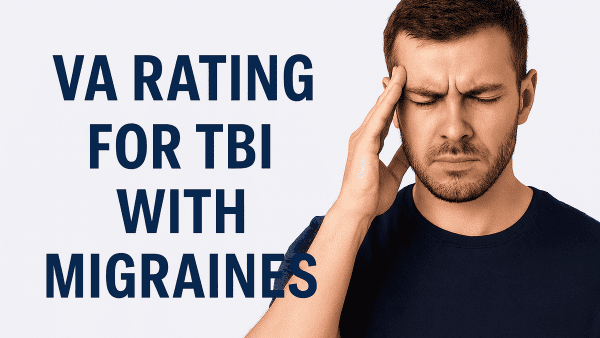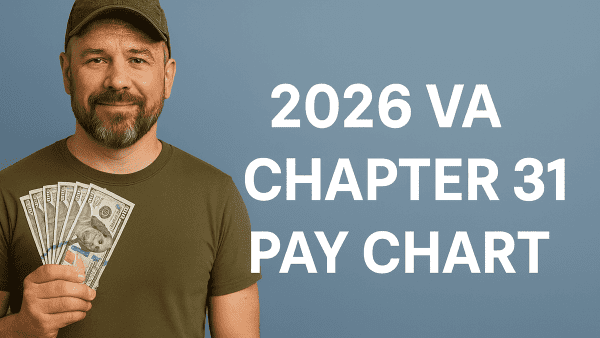Looking for Expert-Level VA Claim Answers?📱Call Us Now! 737-295-2226
If you’re a veteran struggling with urinary incontinence, you may qualify for VA disability benefits.
Urinary incontinence—also known as voiding dysfunction—is rated by the VA under 38 CFR § 4.115a, and compensation depends on how frequently you need to change absorbent materials or use medical devices.
In this updated guide, you’ll learn how the VA assigns a urinary incontinence VA rating, what evidence you need to prove service connection, and how related conditions like PTSD or overactive bladder can qualify as secondary claims.
Table of Contents
Summary of Key Points
- Urinary incontinence is rated under voiding dysfunction using Diagnostic Code 7517 and related bladder conditions in 38 CFR § 4.115a.
- VA ratings range from 20% to 60%, depending on how often absorbent materials must be changed or appliances used.
- Secondary conditions matter—PTSD, prostate injuries, or neurological disorders can cause or worsen urinary incontinence, leading to a secondary VA claim and higher overall compensation.
Urinary Incontinence VA Ratings

The VA uses diagnostic code 7517, which states that a bladder injury should be rated under the voiding dysfunction system.
All of the disabilities below can produce urinary incontinence and can, therefore, be rated under voiding dysfunction:
- DC 7512: Chronic Cystitis
- DC 7515: Calculus in the Bladder
- DC 7516: Fistula of the Bladder
- DC 7517: Injury of the Bladder
- DC 7518: Stricture of the Urethra
- DC 7519: Fistula of the Urethra
- DC 7527: Injury of the Prostate Gland
- DC 7528: Residuals of Treatment for Malignant Neoplasms of the Genitourinary System
- DC 7529: Benign Neoplasm of the Genitourinary System
- DC 7542: Neurogenic Bladder
- DC 7545: Bladder, Diverticulum
How the VA Rates Urinary Incontinence

Depending on how often they cause you to have to change your absorbent materials, these disabilities could get you a urinary incontinence VA rating of 20%, 40%, or 60%.
How to Get Service Connected for Incontinence
To get a urinary incontinence VA rating, you need to be service-connected. For service connection, you will need to have:
- A current medical diagnosis
- An in-service event, injury, or illness
- A medical nexus (link) between the current diagnosis and the in-service event, injury, or illness
Urinary Incontinence Secondary to PTSD
Studies have shown that PTSD is independently associated with urinary incontinence. This means there is a strong correlation between PTSD and urinary incontinence.
This means that if you have a VA rating for PTSD, you could potentially be eligible for a VA rating for a Voiding Dysfunction (also known as urinary incontinence) as a secondary condition.
Secondary conditions are disabilities the VA determines are caused by another rated disability. The thinking is that you would not have this secondary condition if not for your service-connected disability; therefore, your secondary condition is also service-connected.
Secondary conditions are rated in the same way as primary conditions and can lead to a huge boost in your rating.
To get a VA disability rating for urinary incontinence secondary to PTSD, you have to prove your PTSD is causing your incontinence. A correlation isn’t enough. You can prove this through medical records, nexus letters, or Independent Medical Opinion.
VA Rating for Urinary Frequency
Urinary frequency is another common issue that veterans may face, especially if they’ve been exposed to specific hazardous environments or substances during their military service.
VA disability benefits may be available if you’re experiencing urinary frequency, provided you can establish a service connection for this condition.
To obtain a VA rating for urinary frequency, you must demonstrate that your urinary issues are directly related to your military service.
This often involves providing competent medical evidence, including medical histories, diagnostic test results, and expert opinions (like a Nexus Letter). The severity of your condition will determine your VA disability rating, which can range from 10%-40%.
Overactive Bladder VA Rating
Depending on how many times you have to use the restroom and how often you experience urine loss, you could be eligible for a VA rating of 10%, 20%, 40%, or 60%.
Based on this definition, an overactive bladder can potentially be rated under both Urinary Frequency and Voiding Dysfunction.
The Mayo Clinic defines overactive bladder as “frequent and sudden urges to urinate that may be difficult to control and can also lead to unintentional loss of urine.”
However, an overactive bladder is not a disease itself. It’s a group of symptoms caused by an underlying condition. These underlying conditions can be anything from neurological disorders to diabetes or a urinary tract infection.
You’ll need an official medical diagnosis for one of these conditions or a similar one to get an overactive bladder VA rating.
Understanding the Different Types of Urinary Incontinence
It’s important to note that urinary incontinence is not a disease itself but rather a symptom that can have several causes.
While your urinary incontinence VA rating depends on how often you have to change absorbent materials, it’s still useful to know what types of urinary incontinence there are. Your exact symptoms depend on what type of incontinence you have.
5 Types of Urinary Incontinence
- Stress Incontinence: This type occurs when the bladder experiences increased pressure, resulting in urine leakage. Things like coughing, sneezing, laughing, lifting objects, or exercising can contribute to this pressure. Stress incontinence is often associated with weakened pelvic floor muscles, for supporting the bladder and urethra.
- Urge Incontinence: This involves a solid urge to urinate followed by involuntary urine loss before reaching the bathroom. It is often caused by a detrusor muscle that controls bladder contractions. In some cases, neurological conditions or infections may be contributing factors.
- Overflow incontinence: This occurs when the bladder doesn’t completely empty, causing it to fill beyond its capacity. This results in dribbling or continuous leakage of amounts of urine. It’s often associated with conditions like a prostate in men or nerve damage.
- Functional incontinence: This type of incontinence stems from cognitive impairments that make it difficult for individuals to reach the toilet on time. This type of incontinence is common among adults facing mobility issues or dementia.
- Transient incontinence: This is caused by factors such as tract infections, side effects of medication, or constipation. Once the underlying cause is addressed, this type of incontinence usually goes away.
Conclusion
Urinary incontinence can affect every part of daily life—but veterans don’t have to face it without support. If you experience chronic leakage, urgency, or frequent urination related to your service, the VA recognizes these symptoms as part of a rateable voiding dysfunction.
The key is medical evidence: diagnosis, documentation, and a clear nexus linking your condition to military service or a service-connected disability.
Whether your incontinence is primary or secondary to PTSD, prostate issues, or spinal injury, filing a detailed claim—and considering a nexus letter—can make the difference between denial and approval.
You served. You deserve. Make sure you get the compensation you’ve earned.
Need More Assistance?
Most veterans are underrated for their disabilities and, therefore, not getting their due compensation. At VA Claims Insider, we help you understand and take control of the claims process so you can get the rating and compensation you’re owed by law.
Our process takes the guesswork out of filing a VA disability claim and supports you every step of the way in building a fully developed claim (FDC)!
If you’ve filed your VA disability claim and have been denied or have received a low rating—or you’re unsure how to get started—reach out to us! Take advantage of a VA Claim Discovery Call. Learn what you’ve been missing—so you can FINALLY get the disability rating and compensation YOU DESERVE!
(FAQs) Frequently Asked Questions
What types of medical evidence are required to support my claim for VA disability for urinary incontinence?
You should provide comprehensive medical records, including diagnosis reports, treatment history, and statements from healthcare professionals. A Nexus Letter or an Independent Medical Opinion linking your condition to your military service can also strengthen your claim and increase your chances of winning a voiding dysfunction VA rating.
Can I receive VA disability for incontinence and other related conditions, such as PTSD or overactive bladder?
Yes, veterans can receive disability benefits for multiple service-connected conditions, and these benefits can be combined to ensure you receive appropriate compensation for your overall health. You can also receive two ratings for the same condition if it produces different symptoms. If your genitourinary conditions cause frequent urination and involuntary urine loss, you could be eligible for a urinary incontinence VA rating and a urinary frequency VA rating.
How long does it take to get a VA rating for urinary incontinence?
The duration of the claims process can vary depending on factors such as the complexity of your case and the volume of claims being processed. It’s advisable to start the process as soon as possible to avoid unnecessary delays.
What is the VA rating for urinary incontinence?
The VA rates urinary incontinence (voiding dysfunction) at 20%, 40%, or 60%, depending on the frequency of absorbent material changes or the need for a catheter or other appliance. The more severe your leakage or control loss, the higher your rating.
Can urinary incontinence be a secondary VA disability?
Yes. Urinary incontinence can be rated secondary to PTSD, prostate cancer, spinal cord injuries, diabetes, or medications used for service-connected conditions. You’ll need medical evidence linking the two conditions—such as a nexus letter or physician statement.
What is the difference between urinary frequency and incontinence?
Urinary frequency involves frequent urination without loss of control, while incontinence refers to the involuntary leakage of urine. Both can be rated separately if they result from different medical causes.
How do I prove service connection for urinary incontinence?
You’ll need three things: (1) a current diagnosis, (2) evidence of an in-service event or injury, and (3) a medical nexus linking your service or another rated condition to your incontinence. A detailed medical opinion or nexus letter often provides the strongest support.
About the Author

Clay Huston
Clay Huston is a former U.S. Army Reserves Blackhawk Pilot and officer. Clay enlisted in the Army in 2013 and was commissioned as a 2LT in 2017 after earning a business degree from the University of Illinois Champaign-Urbana.
Since separating from the military, Clay has pursued a career as a writer. He also runs the nonprofit notfatherless.org, which fundraises for Children’s Homes in Mexico.



